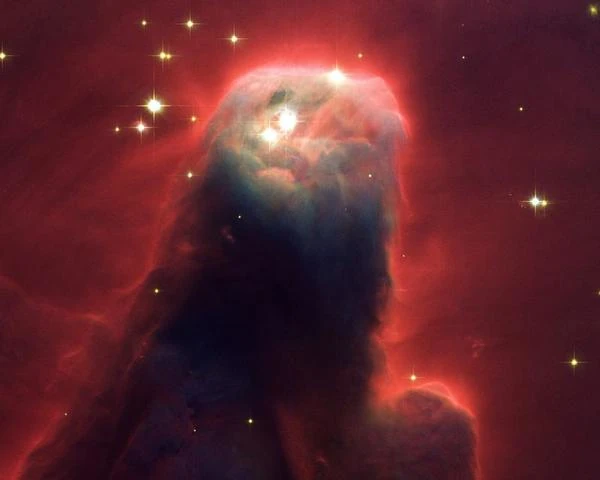
The NGC 2264 is a vast stellar complex located in the Monoceros constellation, about 2,600 light-years away. It includes two remarkable structures: the Cone Nebula, a dark column of dust, and the Christmas Tree Cluster, populated by young blue stars. NGC 2264 is one of the most studied natural laboratories for understanding star formation in an ionized environment.
N.B.:
The Cone Nebula and the Christmas Tree Cluster share the same parent molecular cloud. Their common designation, NGC 2264, does not refer to a single object but to an astrophysical complex encompassing several interconnected structures.
The Cone Nebula spans about 7 light-years and is mainly composed of molecular hydrogen gas (\( H_2 \)) and interstellar dust. The Christmas Tree Cluster, on the other hand, contains more than 600 young stars, some of which are spectral types O and B that emit intense ultraviolet radiation. This radiation interacts with the surrounding molecular cloud, causing photo-ionization of the gas and the formation of an H II region.
N.B.:
Stars of spectral types O and B are among the most massive and hottest on the main sequence. They have surface temperatures between 10,000 K and 50,000 K. These stars emit intense ultraviolet radiation capable of ionizing the surrounding gas, producing H II regions. They have a very short lifespan, on the order of 1 to 10 million years, before evolving into supernovae or neutron stars.
Observations by the Spitzer and Webb telescopes have revealed the presence of numerous YSOs (Young Stellar Objects) and protoplanetary disks. The formation process follows the classic sequence: gravitational collapse, accretion, nuclear ignition, and dispersal of the parent cloud. The energy released by massive stars sculpts the surrounding matter, creating shock fronts and cavities in the nebula. This phenomenon shows that when very massive stars form, they change their environment: their light and powerful winds reshape the gas cloud around them, promoting or inhibiting the birth of new stars.
Observations of NGC 2264 in visible and infrared light reveal distinctive colors called emission lines, produced by hydrogen, oxygen, and sulfur atoms heated by young stars. These light signatures show that the nebula's gas is highly ionized, meaning it has lost some of its electrons. By measuring the shifts in these lines, astronomers have estimated that the gas moves chaotically at speeds between 5 and 10 km/s. Observations in radio waves, particularly at the 2.6 mm wavelength (linked to carbon monoxide, CO), allow tracking the movement of cold gas and identifying areas where new stars are forming.
At the heart of the Cone Nebula, a delicate balance exists between the intense light of young stars and the gravity of the large gas and dust cloud. The strong light energy gradually strips matter from the cloud, fragmenting its surface and creating denser areas where new stars can form. Recent numerical simulations show that the nebula's cone shape results from this balance between radiation pressure and gas density.
| Parameter | Estimated Value | Observation Method | Comment |
|---|---|---|---|
| Distance | 2,600 ± 100 ly | Photometry and parallax (Gaia DR3) | Reliable measurement obtained thanks to precise data from the Gaia satellite. |
| Average age of stars | 3 × 106 years | HR isochrones and PMS models | Indicates a very young population of stars still in the pre-main sequence phase. |
| Temperature of ionized gas | 10,000 K | Hα, [O III] spectroscopy | Typical value for an H II region heated by O and B type stars. |
| Molecular flow velocity | 8 km·s-1 | Radio (CO 2→1) | Reflects the internal turbulence of the gas and the outflows caused by star formation. |